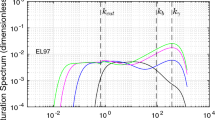Abstract
Data from the Surface Waves and Processes Program (SWAPP) are employed to test current sea-surface drag parameterizations in open ocean conditions. General trends in the data indicate that drag increases with increasing wind speed and wave height, and decreases with wave age. However, scatter in the data limits the use of these parameters and other wave dependent parameterizations for modelling efforts. Upon close inspection, it is found that during the onset of three wind events analyzed separately, each of these parameters correlate well with the drag coefficient. However, the dependence of the drag coefficient on each of these parameters varies markedly from event to event. The disparity appears most closely linked to the turning rate of the wind, indicating that temporal and directional effects may play an important role. A temporal lag of O(4) hours between the rise of the wind and subsequent rise in the drag coefficient is also noticed, further pointing out the complexity of the wind-stress system.
Similar content being viewed by others
References
Charnock, H.: 1955, ‘Wind Stress on a Water Surface’, Quart. J. Roy. Meteorol. Soc. 81, 639–640.
Dobson, F. W., Smith, S. D., and Anderson, R. J.: 1993, ‘Measuring the Relationship Between Wind Stress and Sea State in the Open Ocean in the Presence of Swell’, Atmosphere-Ocean 32, 237–256.
Donelan, M. A.: 1982, The Dependence of the Aerodynamic Drag Coefficient on Wave Parameters, First International Conference on Meteorology and Air/Sea Interaction of the Coastal Zone, The Hague, Netherlands, American Meteorological Society.
Donelan, M. A., Dobson, F. W., Smith, S. D., and Anderson, R. J.: 1993, ‘On the Dependence of Sea Surface Roughness on Wave Development’, J. Phys. Oceanogr. 23, 2143–2149.
Geernaert, G. L.: 1988, ‘Measurements of the Angle Between the Wind Vector and Wind Stress Vector in the Surface Layer Over the North Sea’, J. Geophys. Res. 93, 8215–8220.
Geernaert, G. L.: 1996, ‘On Modeling the Wind Stress Direction Based on Thermal Advection and Surface Waves’, in Mark Donelan (ed.), Proceedings of A Symposium on the Air-Sea Interface: Radio and Acoustic Sensing, Turbulence, and Wave Dynamics, in press.
Geernaert, G. L., Hansen, F., Courtney, M., and Herbers, T.: 1993, ‘Directional Attributes of the Ocean Surface Wind Stress Vector’, J. Geophys. Res. 98, 16571–16582.
Geernaert, G. L.: 1990, ‘Bulk Parameterizations for the Wind Stress and Heat Fluxes’, Surface Waves and Fluxes: Volume 1 – Current Theory, Kluwer Academic Publishers. 336 pp.
Geernaert, G. L., Katsaros, K. B., and Richter, K.: 1986, ‘Variation of the Drag Coefficient and Its Dependence on Sea State’, J. Geophys. Res. 91, 7667–7679.
Hsu, S. A.: 1974, ‘A Dynamic Roughness Equation and Its Application to Wind Stress Determination at the Air-Sea Interface’, J. Phys. Oceanogr. 4, 116–120.
Janssen, P. A. E. M.: 1989, ‘Wave-Induced Stress and the Drag of Air Flow over Sea Waves’, J. Phys. Oceanogr. 19, 745–754.
Large, W. G. and Pond, S.: 1981, ‘Open Ocean Momentum Flux Measurement in Moderate to Strong Winds’, J. Phys. Oceanogr. 11, 324–336.
Phillips, O. M.: 1958, ‘The Equillibrium Range in the Spectrum of Wind-Generated Ocean Waves’, J. Fluid Mech. 4, 426–434.
Rieder, K. F., Smith, J. A., and Weller, R. A.: 1994, ‘Observed Directional Characteristics of the Wind, Wind Stress, and Surface Waves on the Open Ocean’, J. Geophys. Res. 99, 22589–22596.
Rieder, K. F., Smith, J. A., and Weller, R. A.: 1995, ‘Some Evidence of Co-Linear Wind Stress and Wave Breaking’, J. Phys. Oceanogr.in press.
Smith, J. A. and Bullard, G. T.: 1995, ‘Directional Surface Wave Estimates from Doppler Sonar Data’, J. Atmos. Oceanic Technol. 12, 617–632.
Smith, J. A. and Rieder, K. F.: 1997, ‘Wave Induced Motion of FLIP’, Ocean Engineering 24, 95–110.
Smith, S.D.et al.: 1992, ‘Sea Surface Wind Stress and Drag Coefficients: The HEXOS Results’, Boundary-Layer Meteorol. 60, 109–142.
Toba, Y., Iida, N., Kawamura, H., Ebuchi, N., and Jones, I. S. F.: 1990, ‘Wave Dependence on Sea-Surface Wind Stress’, J. Phys. Oceanogr. 20, 705–721.
Weller, R. A., Donelan, M. A., Briscoe, M. G., and Huang, N. E.: 1991, ‘Riding the Crest: A Tale of Two Wave Experiments’, Bull. Amer. Meteorol. Soc. 72, 163–183.
Wu, J.: 1982, ‘Wind-Stress Coefficients Over Sea Surface From Breeze to Hurricane’, J. Geophys. Res. 87, 9704–9706.
Zemba, J. and Friehe, C. A.: 1987, ‘The Marine Atmospheric Boundary Layer Jet in the Coastal Ocean Dynamics Experiment’, J. Geophys. Res. 92, 1489–1496.
Author information
Authors and Affiliations
Rights and permissions
About this article
Cite this article
Rieder, K.F. ANALYSIS OF SEA-SURFACE DRAG PARAMETERIZATIONS IN OPEN OCEAN CONDITIONS. Boundary-Layer Meteorology 82, 355–377 (1997). https://doi.org/10.1023/A:1000289415922
Issue Date:
DOI: https://doi.org/10.1023/A:1000289415922




